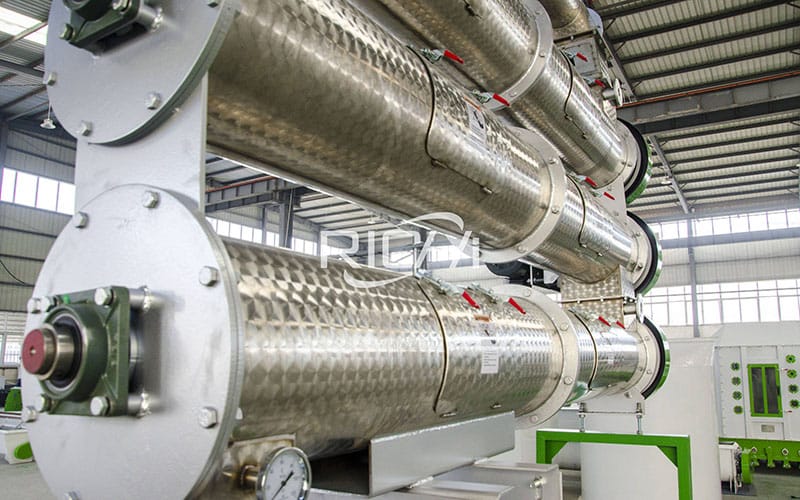1. Moisture control during conditioning section in chicken feed making plant
The conditioning process is the most important process in the processing of chicken pellet feed products. Conditioning moisture, conditioning temperature, and conditioning time are the key factors to control the final material conditioning effect. In the steam conditioning process, moisture is the carrier of heat energy. The amount of conditioning water affects the tempering temperature. The conditioning moisture is adjusted by controlling the amount of steam added, and the conditioning time determines the steam. Utilization of water and heat energy.
Through the analysis of the interrelationship of various factors in the quenching and tempering process, some factors can be adjusted to control some other factors. For example, the conditioning moisture can be controlled by adjusting the amount of steam added and adjusting the length of the conditioning time, and the length of the conditioning time can be adjusted by changing the full coefficient of the material in the chicken feed pellet maker conditioner. This change can increase or decrease the tempering moisture by 0.5-1% under the condition of the same amount of steam added.

(1) Steam quality
Under normal circumstances, the steam pressure of the boiler used in the chicken feed factory is 6-9kg/cm2, and the production pressure is 3-4kg/cm2. The higher the pressure, the lower the steam water content; conversely, the lower the pressure, the higher the humidity, and the higher the steam water content. If the gas distributor and steam supply pipeline are installed effectively and reasonably, and can completely remove the condensed water in the steam transmission pipeline, the steam moisture content entering the conditioner is low.
In the chicken feed production process, corresponding adjustments should be made according to the actual situation, so that the material into the mold can reach the ideal moisture content. In the dry and hot seasons of summer and autumn or when the moisture content of the raw materials used in the formula is low, it is necessary to find ways to increase the moisture content of the materials.
In this case, as long as the production needs are met, the lower the pressure, the better, and the boiler steam pressure can be adjust it to 3-5kg/cm2, the production pressure can be adjusted to 2kg/cm2, close all or part of the traps to increase the steam water content, so as to achieve the purpose of increasing the water content of the quenched and tempered material. Due to the low moisture content of the raw materials, the moisture content of the steam is also low, and the moisture content of the quenched and tempered material is difficult to reach 16% (the shrimp feed is not easy to reach 14%), so closing the trap will not cause blockage.
(2) Conditoning time
Under normal circumstances, the longer the residence time of the material in the conditioner, the more fully mixed with the steam, the moisture absorbed from the steam will increase correspondingly, and the higher the moisture content of the material will be. In the chicken feed plant production process, if the moisture content of the material is low, it is necessary to absorb more moisture by increasing the conditioning time.
Increasing the conditioning time can be done by increasing the effective length of the conditioner, reducing the speed of the conditioner, and adjusting the angle of the conditioner blade. In addition, try to fill the material with the conditioner as much as possible, which is also conducive to the material's absorption of more water, but you should not blindly pursue the improvement of the filling factor and ignore the main function of the conditioner to condition the chicken feed making material.
2. The size and thickness of the die hole of the ring die on chicken feed pelletizer machine
(1) The aperture of the ring die
The pore size of the ring die is different, and the water content of the pellet feed product produced is also different. The die with a small aperture produces feed pellets with a smaller diameter, and the cooling air easily penetrates the pellets. Therefore, more water is taken away during cooling, and the product moisture is lower. Conversely, the die with a large aperture has a larger diameter of feed pellets, and the cold air is not easy to penetrate the pellets, and the water taken away during cooling is less, and the product has a higher moisture content.
(2) The effective thickness of the die
A poultry chicken feed pellet making machine ring die with a larger effective thickness has higher frictional resistance during the chicken feed pelleting process, which makes it difficult for the material to pass through the die hole. The friction temperature is higher, the water loss is higher, and the particle product has a lower moisture content. In contrast, thinner molds have higher moisture content.


